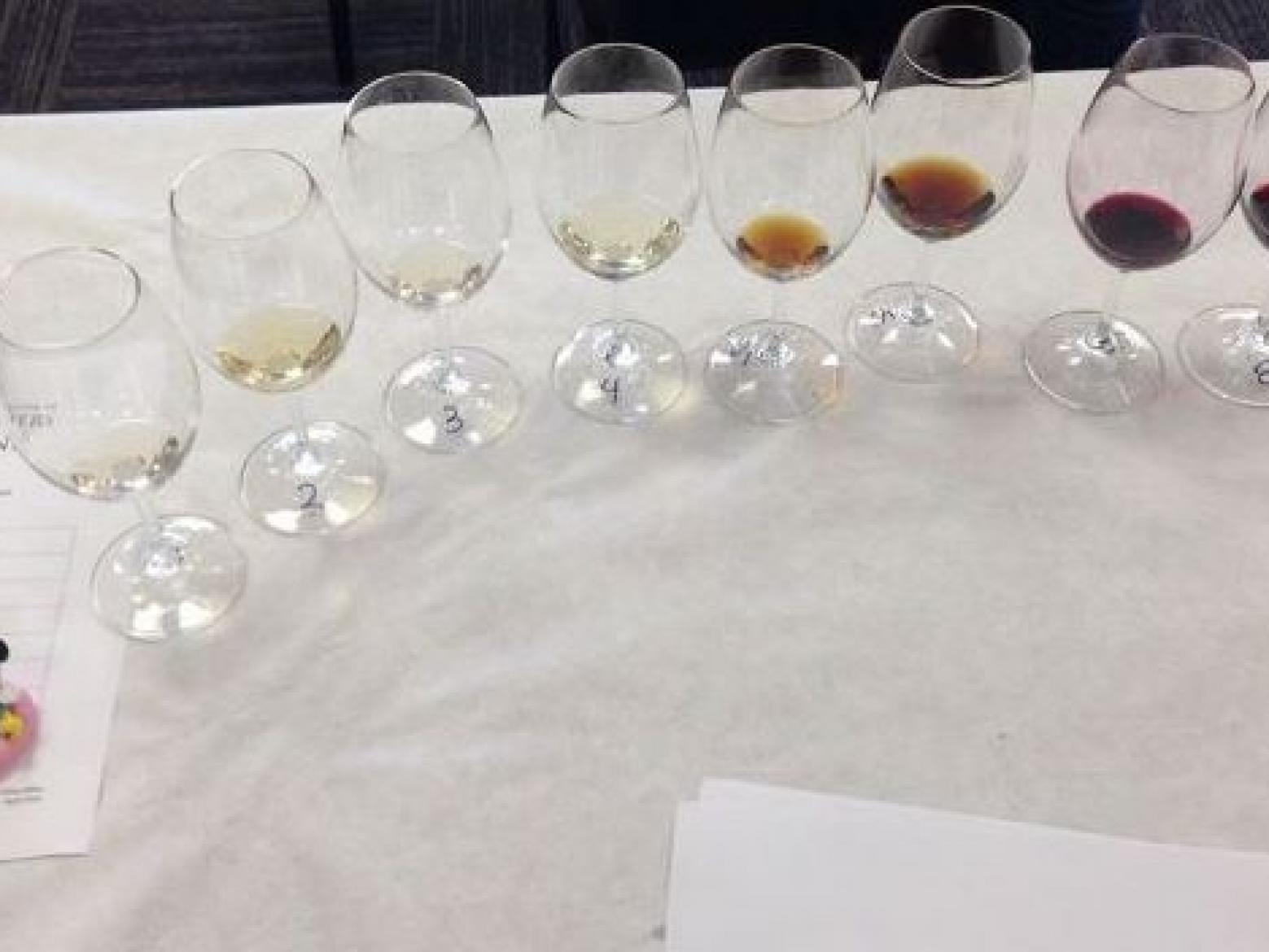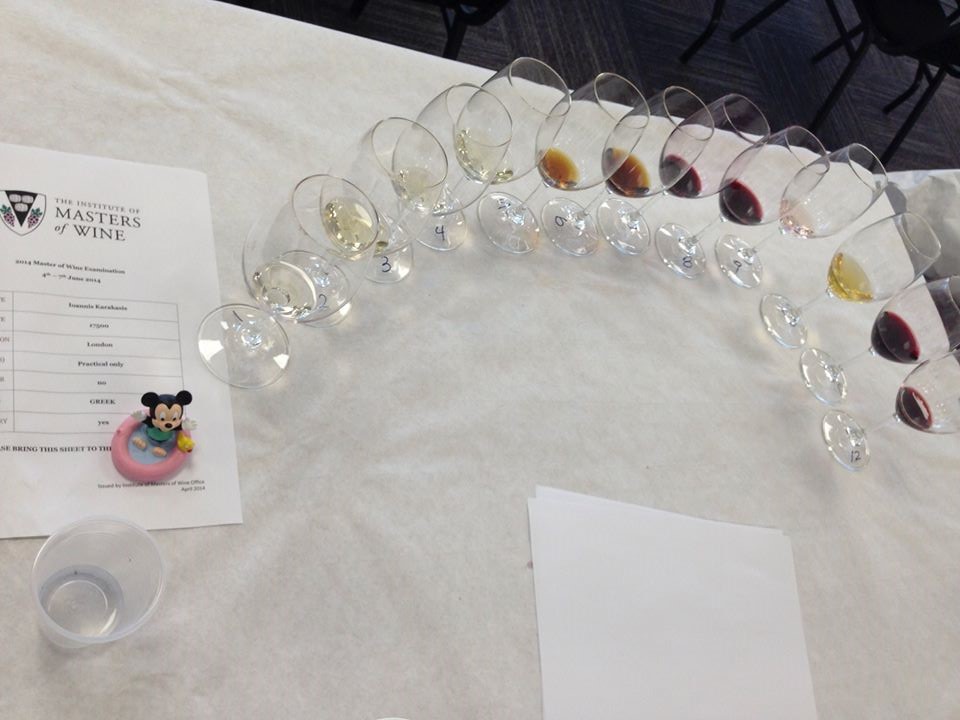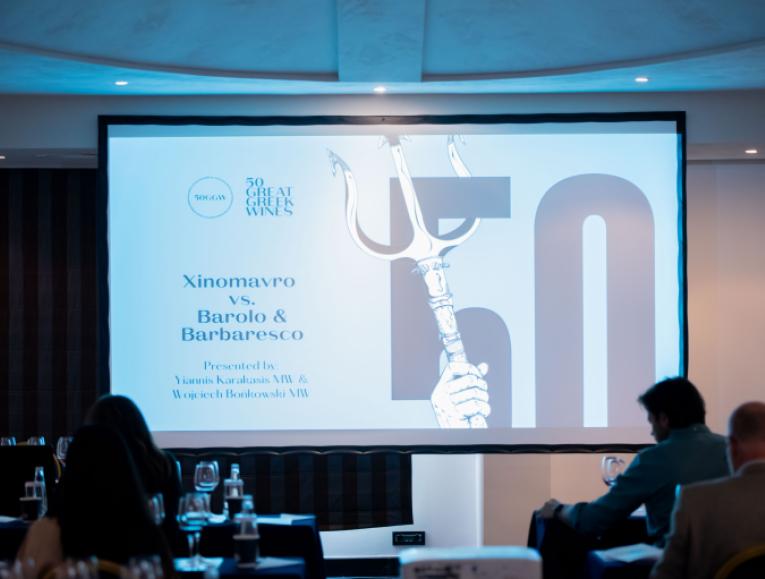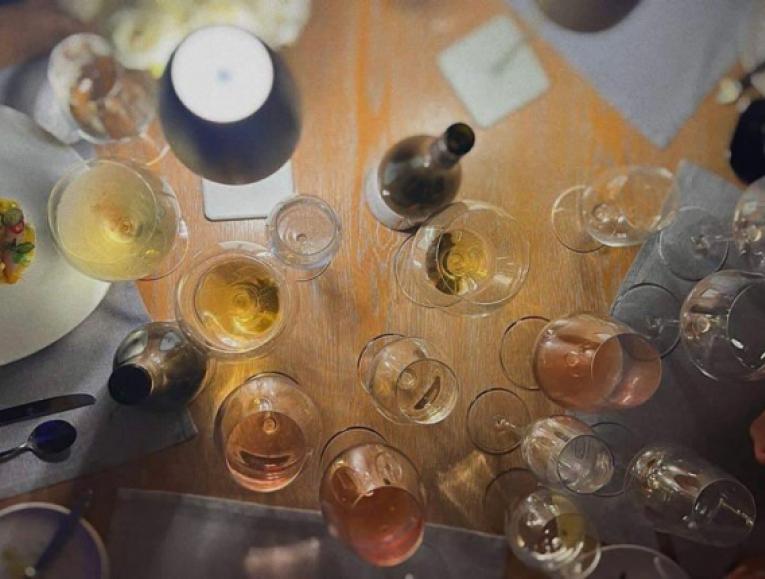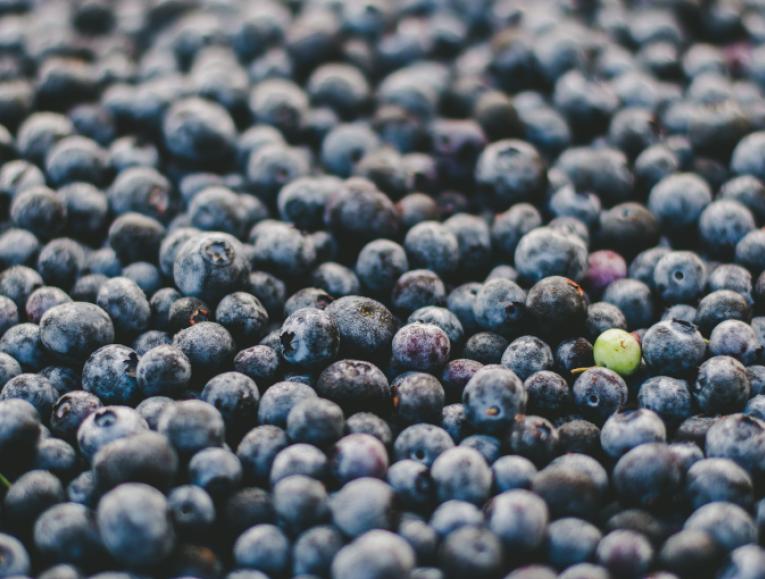Passage from the land of fire - the MW practical exam chronicle
Sunday afternoon; on my way back from Nemea together with my jet pilot wingman Gregory.
The Great Days of Nemea are finally over and after participating in an extensive two-day tasting of Nemea's wines with some lovely Agiorgitiko, my anxiety for the announcement of the Master of Wine exam result the day after, is now reaching overtorque( in aviation referring to the excess power) levels!
Sunday evening; brief stop at Paradiso restaurant to drop Gregory on my way back home at Glyfada.
My mind is now under attack.
Have I managed to pass the tasting or have I failed for a second time? Am I sensing perhaps a good feeling about it?
I've succeeded in passing the theoretical part at my fist attempt and if I only pass the practical part, it will only be just a step away, i.e. the submission of a successful Research paper, to add two small, yet prestigious letters next to my name.
I find myself feeling that I may have passed, but I immediately refuse to accept it as a possibility and prepare myself for the worst scenario.
In either case, whether it is fly me to the moon or keep walking I am determined to move forward.
Monday; the final countdown.
The results are expected early in the morning and by half past six a.m. I am already in front of my laptop screen constantly checking my mail.
Shortly after nine my phone rings and the area code +44 pops on my inserting calls. Relief. They only give you a call if the news is good or should I say really good.
Tears starting to fall from my eyes as I'm realizing that I can finally enjoy wine without the torture of compulsively assessing the alcohol levels or the tannins. No more wondering around with twelve glasses in my hand, no more blind tastings, Hallelujah!!!
Practical Exam under the microscope
The main difference between the practical exam and the theoretical one is the extremely low percentage of passes, 16% in comparison with 31% the previous year, reaching this year something close to just 11 passes. So, no matter how well you might have been prepared it is a "sudden death" test.
A moment of blacking out, panic attack that you have no idea what is the wine (a rather frequent fact), and boom! The time has elapsed and the game is over!
As the possibility to choose some of the questions in the theory part, here there is only a way forward; you must answer all questions. Lack of concentration and a few bad moments and "FAIL" will appear in bold letters!
Paper 1: White wine
In the first question I've succeeded in spotting the country, i.e. Australia and three out of the four wines (no Riesling in there), failing in recognizing the Viognier wine of Yalumba, as Marsanne. The second wine was clearly a Semillon by its waxy character, piercing acidity etc, and a nice bunker for Australia but if it was misread there could be trouble since the other two wines were a Chardonnay and a Sauvignon Blanc.
The second question for a single variety was crying out for Riesling originating from four different countries. Not so easy as it seems because if you misplace just one wine chances are that you will get wrong easily two wines. I got two spot-on, the Alsace Grand Cru and the Aussie, while I did mix up the one from Pfaltz with Austria, a justifiable mistake I guess.
The wording of the third question was rather confusing, making things even harder bearing in mind that we had to deal with four different wines from two different varieties and two different countries. The varieties were clearly Chardonnay and Sauvignon Blanc but an excellent Kumeu River Coddington from Auckalnd New Zealand made me feel like Burgundy as its quality reaches Premier Cru level and oak is very well handled and defined. As a consequence I've reached wrong conclusions as to the countries of origin and essentially this question was the only one in the three papers that I completely missed a big part.
Paper 2: Red wine
After an initial hesitation and the familiar dilemma Syrah or Cabernet Sauvignon I went for the first one, which gratefully was the right one, getting the origins pretty close as well.
The second question was also complicated in a way; four wines from two estates, one region and four distinct vintages. Bordeaux was very much welcomed arguing for St Estephe (examining of course the neighboring Pauillac) and Pomerol. It was finally Pauillac and Pomerol from Chateau Lynch Bages and Nenin, exquisite wines to taste in an exam!
Third and final question with four wines and one country. I hesitated for a while considering as well Italy besides Spain but tannins were softer, fruit riper and acid to the moderate level and the last wine was a traditional oaked Rioja. Three out of four there, and too bad I missed the Bierzo wine since I have tried Petalos quite a few times. What a lovely wine by the way in a bargain price...
Paper 3: Mix & match
Eleven out of twelve right missing just the Amarone seems like a miracle now!
The wine menu had a natural wine from Georgia vs the Brangelina rose; have to admit and please don't hold that against me that I really enjoyed Pheseant's Tears. The power of theory proved to be invincible as I identified the Vouvray petillant, a style that I had never tasted before as far as I remember.
The challenge in the practical part of the MW exam is not to just nail wines but to analyze them after nailing like 6 to 7 for each paper. It needs sound sound arguments and cautious expressions.
Practical exam? DONE!
Hello Research Paper!!! Any ideas will be very much welcomed since I am wondering around Naoussa searching for a topic!
Here are the wines and questions in detail:
Practical Paper 1
Question 1.
Wines 1-4 come from the same country.
With reference to all four wines
a) Identify the country of origin. (16 marks)
For each of the four wines
b) Identify the region of origin as closely as possible. (4 x 5 marks).
c) Discuss the key winemaking techniques used to produce this style. (4 x 8 marks)
d) Discuss quality in relation to the region of origin. (4 x 8 marks)
Question 2.
Wines 5-8 come from four different countries and are made from the same single grape variety.
With reference to all four wines
a) Identify the grape variety. (24 marks)
For each wine
b) Identify the origin as closely as possible. (4 x 10 marks)
c) Discuss quality and style. (4 x 9 marks)
Question 3.
Wines 9-12 are all made from a single variety. Two varieties are represented.
a) Divide the wines into their respective varietal pairs using both wines to identify the variety. (2 x 20 marks)
In addition to being paired by variety, they are also paired by country.
b) Divide the wines into their respective pairs by country and discuss their individual origins as closely as possible. (2 x 20 marks)
c) Taking one of the geographical pairs you have identified above, compare and contrast their method of production. (10 marks)
d) For the other geographical pair of wines you have selected, which characteristics might you highlight to a potential customer? (10 marks)
1. Viognier, Organic, Yalumba 2012 South Australia, Australia (14.5%)
2. Semillon, Bin 9000, McGuigan 2007 Hunter Valley, Australia (11%)
3. Chardonnay, Shadowfax Wines 2009 Victoria, Australia (13%)
4. Sauvignon Blanc/Semillon, Suckfizzle, Stella Bella Wines 2009 Margaret River, Australia (13%)
5. Watervale Riesling, Mount Horrocks 2013 Clare Valley, South Australia, Australia (12.5%)
6. Riesling, Grand Cru Muenchberg, Domaine Ostertag 2011 Alsace, France (13.5%)
7. Riesling, Domaine Rewa 2011 Central Otago, New Zealand (11.5%)
8. Deidesheimer Kieselberg Riesling, Kabinett trocken, Dr von Bassermann-Jordan 2011 Pfalz, Germany (11.5%)
9. Chablis, Grand Cru Les Clos, Duplessis 2010 Burgundy, France (13%)
10. Chardonnay, Coddington, Kumeu River 2011 Auckland, New Zealand (13.5%)
11. Sancerre, Domaine Vacheron 2012 Loire, France (12.5%)
12. Sauvignon Blanc, Tinpot Hut 2013 Marlborough, New Zealand (13%)
Practical Paper 2
Question 1.
Wines 1-4 are all made from the same single variety, but come from four different countries.
With reference to all four wines
a) Identify the grape variety. (28 marks)
For each wine
b) Identify the origin as closely as possible. (4 x 8 marks)
c) Comment on the quality and commercial appeal. (4 x 10 marks)
Question 2.
Wines 5-8 come from two different estates. Two wines from estate A, two wines from estate B. All four wines are from the same region but from four different vintages.
a) Divide the wines into their respective pairs and identify their origin as closely as possible. (2 x 16 marks)
b) Within each pair, compare and contrast relative quality. (2 x 18 marks)
For each wine
c) Identify the vintage giving reasons for your conclusion. (4 x 8 marks)
Question 3.
Wines 9-12 are all from the same country.
With reference to all four wines
a) Identify the country of origin. (28 marks)
For each wine
b) Identify the specific origin with reference to the grape variety(ies) used. (4 x 9 marks)
c) Comment on the quality and maturity. (4 x 9 marks)
1. Saint Joseph, Silice, Pierre et Jerome Coursodon 2010 Rhône, France (14%)
2. Syrah, La Cumbre, Errázuriz 2008 Aconcagua Valley, Chile (14.5%)
3. Syrah, Qupé 2011 Central Coast, California, USA (13.5%)
4. Shiraz, The Dead Arm, d'Arenberg 2009 McLaren Vale, South Australia, Australia (14.5%)
5. Château Lynch Bages 2006 Pauillac, Bordeaux, France (13%)
6. Château Nenin 2008 Pomerol, Bordeaux, France (13.5%)
7. Château Lynch Bages 2009 Pauillac, Bordeaux, France (13.5%)
8. Château Nenin 2010 Pomerol, Bordeaux, France (14.5%)
9. Villacreces 2009 Ribera del Duero, Spain (14%)
10. Petalos, J Palacios 2011 Bierzo, Spain (14.5%)
11. Simply Garnacha, Bodegas Borsao for Tesco 2013 Campo de Borja, Spain (13.5%)
12. Viña Ardanza Reserva, La Rioja Alta 2004 Rioja, Spain (13.5%)
Practical Paper 3
Question 1.
Wines 1-4 are from four different countries. None of the wines is from Champagne.
For each wine
a) Identify the origin as closely as possible with reference to the grape variety(ies) used. (4 x 10 marks)
b) Discuss the method of production. (4 x 7 marks)
c) Comment on quality and commercial position. (4 x 8 marks)
Question 2.
Wines 5-8 are from three different countries.
For each wine
a) Identify the country and region of origin. (4 x 7 marks)
b) With reference to grape varieties used, discuss the method of production. (4 x 7 marks)
c) Comment on the quality and ability to improve in the bottle. (4 x 7 marks)
d) State alcohol level (%). (4 x 2 marks)
e) State residual sugar (g/l). (4 x 2 marks)
Question 3.
Wines 9-10 are produced from two different countries in Europe.
For each wine
a) Discuss the method of production. (2 x 10 marks)
b) Comment on the quality. (2 x 8 marks)
For both wines
c) Compare and contrast the commercial potential. (14 marks)
Question 4.
Wines 11-12 are produced in different countries.
For each wine
a) Identify the country and region of origin as closely as possible.
(2 x 10 marks)
b) Discuss the method of production. (2 x 7 marks)
c) Comment on the quality and maturity. (2 x 8 marks)
1. Cava, L'Hereu, Raventos i Blanc 2011 Penedès, Spain (12%)
2. Vouvray Brut, Francois Pinon NV Loire, France (12.5%)
3. Riesling, Sektmanufaktur Graf 2010 Pfalz, Germany (12.5%)
4. Le Reve, Blanc de Blancs, Domaine Carneros 2006 Carneros, California, USA (12%)
5. East India Solera Sherry, Lustau NV Jerez, Spain (20%)
6. 15 year-old Malmsey, Blandy's NV Madeira, Portugal (19%)
7. Six Grapes, Reserve Port, Graham's NV Port, Portugal (20%)
8. Banyuls, Rimage, Domaine La Tour Vieille 2011 Roussillon, France (16%)
9. Miraval Rosé 2013 Côtes de Provence, France (13%)
10. Pheasant's Tears, Rkatsiteli 2011 Kakheti, Georgia (12.5%)
11. Ménage à Trois, Folie à Deux Winery 2012 California, USA (13.5%)
12. Amarone della Valpolicella, Allegrini 2009 Veneto, Italy (15.5%)
